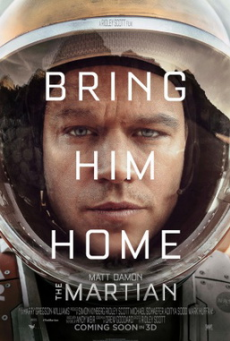
Earlier this year, NASA released a report confirming that there is water on the planet Mars. Although there’s no ‘Life on Mars’ yet (sorry David Bowie), this is still a massive step forward in the scientific understanding of our solar system, and the wider universe around us. Our fascination with space and particularly ‘The Red Plant’ is not solely scientific: the recent science fiction film “The Martian,” based on Andy Weir’s 2011 novel, has received an outstanding amount of praise. Starring Matt Damon and Jessica Chastain, “The Martian” follows Mark Watney, a botanist exploring the surface and possibilities of Mars. After a freak storm, Watney is assumed dead, and the crew leave him behind. However, the scientist is still alive, and begins his struggle to survive, and to return home.
The premise implies an exceedingly existential film, one that spurns the audience to question their place in the universe. Furthermore, Damon’s lone figure on the poster title suggests a movie that revolves around his character’s speculations, with few others for the audience to connect with. Sound familiar? (Cough, “Gravity”, cough). Whilst the 2013 Box Office Hit was certainly deserving of praise, “The Martian” takes a similar premise, but incorporates a wider story. This is not about a single human surviving in the impossible vastness of space. It is about the whole world joining together in hope. Not the struggle of an individual, but of a collected, global community. This very, very smart move means that the entire audience can connect with the film, rather than the few who see themselves in a protagonist.
The second, vital factor which, in my opinion, makes “The Martian” one of the greatest ‘space’ films of the last decade: it doesn’t take itself too seriously. The comedic one-liners, and the humour with which Watney deals with each new challenge presented means he is simply a more likeable character. With film after film portraying a post apocalyptic earth, and humanity hurting one another again and again, it is nice to finally have one that is surprisingly optimistic. This optimism is presented again, and again, but one of the most poignant moments has to be (spoilers!) Watney’s successful attempt to grow potatoes. Moving Martian soil inside what remains of the living quarters, and creating water from burning alcohol, the growth of a plant on a seemingly barren planet, despite all odds, is nothing less than beautiful.
The wonderful critical reception of both the book, and the film, is certainly representative of its superb story. The CGI alone is deserving of an award; the constant landscape shots of Mars taking each audience member’s breath away. There is a great contrast between the smallness of a single human consciousness, and the vastness of the planet. Between the barren nature of Mars, and the hope and life of humanity. Manohla Dargis, writer for ‘The New York Times’ managed to encapsulate the film in a single sentence, stating it has a “great, persistent theme of what it means to be human.”
Image: https://upload.wikimedia.org/wikipedia/en/c/cd/The_Martian_film_poster.jpg

0 Comment:
Be the first one to comment on this article.